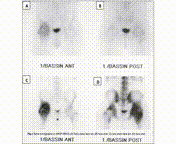The Role of 99mTc-HMDP Bone Scintigraphy in the Management of Neurogenic Para- Osteo-Arthropathies (NAOP)
DOI:
https://doi.org/10.59667/sjoranm.v8i1.17Keywords:
Neurogenic Para- Osteo- Arthropathies (NAOP), ectopic juxta-articular peri- or para-osseous ossifications, maturity of the ossification, Brooker's classificationAbstract
Neurogenic para-osteo-arthropathies (NAOP) are characterized by ectopic juxta-articular peri- or para-osseous ossifications. Diagnosis of these conditions is often delayed. They are frequently associated with central neurological disorders and are rarely observed in cases of peripheral neuropathy. Bone scintigraphy is crucial for determining the maturity of the ossification, optimizing surgical interventions, and preventing recurrence.
References
Wharton GW, Morgan TH. Ankylosis in the paralyzed patient. J Bone Joint Surg Am. 1970;52(1):105-12.
Orzel JA, Rudd TG. Heterotopic bone formation: clinical, laboratory, and imaging correlation. J Nucl Med. 1985;26(2):125-32.
Citak M, Suero EM, Backhaus M, Aach M, Godry H, Meindl R, et al. Risk factors for heterotopic ossification in patients with spinal cord injury: a casecontrol study of 264 patients. Spine (Phila Pa 1976). 2012;37(23):1953-7.
Melo RM, Mendonça MQ, Mendonça ET, Mendonça EQ. Ossificação heterotópica em saco herniário incisional. Rev Col Bras Cir. 2012;39(2):151-4.
Garland DE. A clinical perspective on common forms of acquired heterotopic ossification. Clin Orthop Relat Res. 1991;(263):13-29.
Coelho CV, Beraldo PS. Risk factors of heterotopic ossification in traumatic spinal cord injury. Arq Neuropsiquiatr. 2009;67(2B):382-7.
Pélissier J, Petiot S, Bénaïm C, Asencio G. Management of neurogenic paraosteoarthropathies (POAN) in patients with cranioencephalic trauma. Ann Réadaptation Méd Phys 2002 ; 45: 188-97.
Shehab D, Elgazzar H, Collier B. Heterotopic ossification. J Nucl Med. 2002;43:346-53.
LimaMC, PassarellMC, Dario V, Lebani BR, Silva Monteiro PHS. RamosCD: The use of SPECT/CT in the evaluation of heterotopic ossification in para/tetraplegics. Acta Ortop Bras. 2014;22:12-6.
Lin Y, Lin WY, Kao CH, Shih C, Tsai SC. Easy interpretation of heterotopic ossification demonstrated on bone SPECT/CT. Clin Nucl Med. 2014;39:62-3.
Shawgi M. Heterotopic ossification of the hips in a patient with Guillain-Barré syndrome demonstrated on SPECT/CT. Clin Nucl Med. 2012;37:e253-4.
Chalmers J, Gray DH, Rush J. Observations on the induction of bone in soft tissues. J Bone Joint Surg Br. 1975;57:36-45.v
Urist MR, Nakagawa M, Nakata N, Nogami H. Experimental myositis ossificans: cartilage and bone formation in muscle in response to diffusible bone matrixderived morphogen. Arch Pathol Lab Med. 1978;102:312-316.
Jensen LL, Halar E, Little J, Brooke MM. Neurogenic heterotopic ossification. Am J Phys Med Rehabil. 1987;66:351-363.
Rossier AB, Bussat P, Infante F, et al. Current facts on para-osteoarthropathy (POA). Paraplegia. 1973;11:36- 78.
Wharton GW, Morgan TH. Ankylosis in the paralyzed patient. J Bone Joint Surg Am. 1970;52:105-112.
Freed JH, Hahn H, Menter R, Dillon T. The use of three-phase bone scan in the early diagnosis of heterotopic ossification (HO) and in the evaluation of Didronel therapy. Paraplegia. 1982;20:208-216.
Moyen B, Chouteau J. Scintigraphie osseuse de l'appareillocomoteur. Médecine Nucléaire, Imagerie Fonctionnelle etMétabolique 2003; 27 (11): 596-9.
Brooker AF, Bowerman JW, Robinson RA, Riley LH Jr. Ectopic ossification following total hip replacement: incidence and method of classification. J Bone Joint Surg Am. 1973;55:1629-1632.
Sawyer JR, Myers MA, Rosier RN, Puzas JE. Heterotopic ossification: clinical and cellular aspects. Calcif Tissue Int. 1991;49:208-215.
Orzel JA, Rudd TG. Heterotopic bone formation: clinical, laboratory and imaging correlation. J Nucl Med. 1985;26:125-132.
Helms CA. "Skeletal don't touch lesions. In: Brant WE, Helms CA; eds. Fundamentals of Diagnostic Radiology. Baltimore, MD: Williams & Wilkins; 1994:963-975.
Mysiw WJ, Tan J, Jackson RD. Heterotopic ossification. Am J Phys Med Rehabil. 1993;72:184-187.
Garland DE. A clinical perspective on common forms of acquired heterotopic ossification. Clin Orthop. 1991;263:13-29.
Tyler JL, Derbekyan V, Lisbona R. Early diagnosis of myositis ossificans with Tc-99m diphosphonate imaging. Clin Nucl Med. 1984;9:256-258.
Bossche L, Vanderstraeten G. Heterotopic ossification: a review. J Rehabil Med. 2005;37:129-36.
Meriem Haloua, Younes Houmada, Youssef Alaoui Lamrani, Moustapha Maaroufi, Siham Tizniti, Meryem Boubbou. Neurogenic para-osteoarthropathy of the hip : About two cases 2017 ; Vol 95 ( n°05 ) : 381-384
Tibone J, Sakimura I, Nickel VL, Hsu JD. Heterotopic ossification around the hip in spinal cord-injured patients: a long-term follow-up study. J Bone Joint Surg Am. 1978;60:769-775.
Mohammad A. Ghanem1,2; Shurouq Dannoon1,3; Abdelhamid H. Elgazzar1,3. The added value of SPECT-CT in the detection of heterotopic ossification on bone scintigraphy. Skeletal Radiology
Lima MC, PassarellMC, Dario V, Lebani BR, Silva Monteiro PHS. RamosCD: The use of SPECT/CT in the evaluation of heterotopic ossification in para/tetraplegics. Acta Ortop Bras. 2014;22:12-6.

Downloads
Published
Issue
Section
License
Copyright (c) 2024 Sofia CHKIKAR, Dr Assia Seddouki, Pr Nadia Ismaili Alaoui

This work is licensed under a Creative Commons Attribution 4.0 International License.
This license requires that reusers give credit to the creator. It allows reusers to distribute, remix, adapt, and build upon the material in any medium or format, even for commercial purposes.








